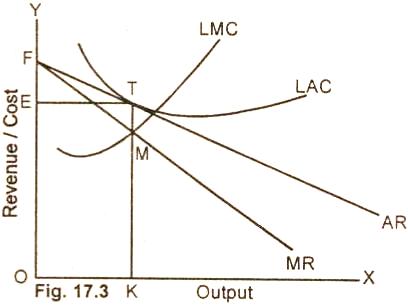Equilibrium Price and Output in the Long Run
Under Monopolistic/Imperfect Competition:
Long
Run Zero Economic Profits:
In the long run, the
firms are able to alter the scale of plant according to the
changed conditions of demand for a product in the market. They
can also
leave or enter the
industry. If the firms are earning abnormal profits in the
short run, then new firm will enter the 'product group'
(industry). The tendency of the new firms to enter the industry
continues till the abnormal profits are competed away and the
firms economic profits are zero. In case the monopolistically
competitive firms realize losses in the short-run, then some of
the firms will leave the industry. The exit of the firm
continues till zero economic profits are restored with the
operating firms.
In the long-run,
there are no entry barriers for the new firms. The incoming
firms install latest machinery and try to differentiate their
products from those of the established firms. The old firms
operating with .the used machinery try to match up with the new
entrants by improved variety of products in their group. They
increase expenditure on advertisement and on other sales
promotional measures. They employ more qualified staff for.
making technical improvement in their products. Since all the
firms for their existence incur additional expenditure for
improving the quality of the products, the cost curves of all
the firms move up. Due to entry of new firms in the industry and
higher costs of production, the output of each competing firm is
reduced. There is, therefore, a waste in the economic resources
of the country. The equilibrium price and output in the long-run
is explained with the help of a diagram.
Diagram:

In the figure (17.3),
the higher shifted long-run marginal cost curve intersects the
higher shifted marginal revenue curve at point M. The firm at
this raised equilibrium point, produces the reduced level of
output OK. It sells this output at price TK as at point T, LAC
is a tangent to the demand or average revenue curve at its
minimum point. The total revenue of the firm is equal to the area OETK. The
total costs of the firm are also
equal to the area OETK. The firm is earning only zero or
normal economic profits. As the monopolistically competitive
firm sets a price higher than that minimum average cost in the
long-run, the firm therefore produces a smaller output. Since
all the firms in the product group produce less at higher price,
there is, therefore, an apparent waste of resources and
exploitation of the consumers.
The advocates of
monopolistic competition are of the opinion that if
consumers get differentiated products at slightly higher prices
(than with no choice under
perfect competition), the consumers are then not exploited.
There is no wasting of resources either, as the consumer's
welfare increases with the product differentiation.
Relevant Articles:
|